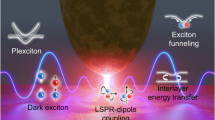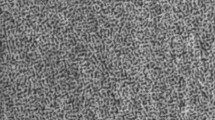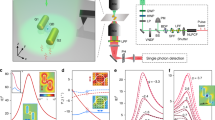Abstract
Resonant optical nanoantennas hold great promise for applications in physics and chemistry1,2,3,4,5,6. Their operation relies on their ability to concentrate light on spatial scales much smaller than the wavelength. In this work, we mechanically tune the length and gap between two triangles comprising a single gold bow-tie antenna by precise nanomanipulation with the tip of an atomic force microscope. At the same time, the optical response of the nanostructure is determined by means of dark-field scattering spectroscopy. We find no unique single ‘antenna resonance’. Instead, the plasmon mode splits into two dipole resonances for gap sizes on the order of a few tens of nanometres, governed by the full three-dimensional shape of the antenna arms. This result opens the door to new nano-optomechanical devices, where mechanical changes on the nanometre scale control the optical properties of artificial structures.
This is a preview of subscription content, access via your institution
Access options
Subscribe to this journal
Receive 12 print issues and online access
$209.00 per year
only $17.42 per issue
Buy this article
- Purchase on Springer Link
- Instant access to full article PDF
Prices may be subject to local taxes which are calculated during checkout



Similar content being viewed by others
References
Sundaramurthy, A. et al. Toward nanometer-scale optical photolithography: Utilizing the near-field of bowtie optical nanoantennas. Nano Lett. 6, 355–360 (2006).
Aizpurua, J. et al. Optical properties of coupled metallic nanorods for field-enhanced spectroscopy. Phys. Rev. B 71, 235420 (2005).
Farahani, J. N., Pohl, D. W., Eisler, H. J. & Hecht, B. Single quantum dot coupled to a scanning optical antenna: A tunable superemitter. Phys. Rev. Lett. 95, 17402 (2005).
Cubukcu, E., Kort, E. A., Crozier, K. B. & Capasso, F. Plasmonic laser antenna. Appl. Phys. Lett. 89, 93120 (2006).
Novotny, L. Effective wavelength scaling for optical antennas. Phys. Rev. Lett. 98, 266802 (2007).
Challenger, W. A. et al. Light delivery techniques for heat-assisted magnetic recording. Jpn J. Appl. Phys. 42, 981–988 (2003).
Xu, H. & Käll, M. Surface-plasmon-enhanced optical forces in silver nanoaggregates. Phys. Rev. Lett. 89, 246802 (2002).
Haes, A. J. & van Duyne, R. P. A nanoscale optical biosensor: Sensitivity and selectivity of an approach based on the localized surface plasmon resonance spectroscopy of triangular silver nanoparticles. J. Am. Chem. Soc. 124, 10596–10604 (2002).
Schuck, P. J., Fromm, D. P., Sundaramurthy, A., Kino, G. S. & Moerner, W. E. Improving the mismatch between light and nanoscale objects with gold bowtie nanoantennas. Phys. Rev. Lett. 94, 17402 (2005).
Mühlschlegel, P., Eisler, H.-J., Martin, O. J. F., Hecht, B. & Pohl, D. W. Resonant optical antennas. Science 308, 1607–1609 (2005).
Fischer, U. C. & Zingsheim, H. P. Submicroscopic pattern replication with visible light. J. Vac. Sci. Technol. 19, 881–885 (1981).
Deckman, H. W. & Dunsmuir, J. H. Natural lithography. Appl. Phys. Lett. 41, 377–379 (1982).
Burmeister, F. et al. From mesoscopic to nanoscopic surface structures: Lithography with colloid monolayers. Adv. Mater. 10, 495–497 (1998).
Draine, B. T. & Flatau, P. J. User Guide for the Discrete Dipole Approximation Code DDSCAT 6.1. <http://arxiv.org/abs/astro-ph/0409262> (2004).
Glang, R. Materials and processes for passive thin-film components. J. Vac. Sci Technol. 3, 37–48 (1966).
Haq, K. E., Behrndt, K. H. & Kobin, I. Adhesion mechanism of gold-underlayer film combinations to oxide substrates. J. Vac. Sci Technol. 6, 148–152 (1969).
Sundaramurthy, A. et al. Field enhancement and gap-dependent resonance in a system of two opposing tip-to-tip Au nanotriangles. Phys. Rev. B 72, 165409 (2005).
Kelly, K. L., Coronado, E., Zhao, L. L. & Schatz, G. C. The optical properties of metal nanoparticles: The influence of size, shape, and dielectric environment. J. Phys. Chem. B 107, 668–677 (2003).
Landau, L. D. & Lifshitz, E. M. Electrodynamics of Continuous Media (New York, Pergamon, 1960).
Göger, G. et al. Ultrafast spectroscopy of large-momentum excitons in GaAs. Phys. Rev. Lett. 84, 5812–5815 (2000).
Betz, M. et al. Nonlinear optical response of highly energetic excitons in GaAs: Microscopic electrodynamics at semiconductor interfaces. Phys. Rev. B 65, 85314 (2002).
Acknowledgements
We gratefully acknowledge financial support from the Deutsche Forschungsgemeinschaft (DFG) through SFB 513, the Kompetenznetz Funktionelle Nanostrukturen Baden-Württemberg, and a grant from the Ministry of Science, Research and Arts Baden-Württemberg. We acknowledge the generous help of M. Fuchs, S. Gerlach, K. Diederichs, R. Stadelhofer and W. Benger by providing extensive computer power for the DDA calculations. We acknowledge the help of H. Ballot and A. Habenicht with the colloidal masks.
Author information
Authors and Affiliations
Contributions
Jörg Merlein and Matthias Kahl contributed equally to this work.
Corresponding authors
Supplementary information
Rights and permissions
About this article
Cite this article
Merlein, J., Kahl, M., Zuschlag, A. et al. Nanomechanical control of an optical antenna. Nature Photon 2, 230–233 (2008). https://doi.org/10.1038/nphoton.2008.27
Received:
Accepted:
Published:
Issue Date:
DOI: https://doi.org/10.1038/nphoton.2008.27
This article is cited by
-
Plasmonic phenomena in molecular junctions: principles and applications
Nature Reviews Chemistry (2022)
-
Far-IR to deep-UV adaptive supercontinuum generation using semiconductor nano-antennas via carrier injection rate modulation
Applied Nanoscience (2022)
-
Quantitative sampling of atomic-scale electromagnetic waveforms
Nature Photonics (2021)
-
Design of Aluminum Bowtie Nanoantenna Array with Geometrical Control to Tune LSPR from UV to Near-IR for Optical Sensing
Plasmonics (2020)
-
Selective far-field addressing of coupled quantum dots in a plasmonic nanocavity
Nature Communications (2018)



